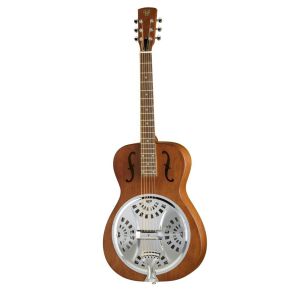Resophonic Guitar
 The Resophonic guitar was invented by John Dopyera in the mid 1920s in an attempt to make an acoustic loud enough to compete with big bands in the pre-electric guitar era. In 1927, he partnered with George Beauchamp, later of Rickenbacker fame, to form the National String Instrument Corporation, which released the first Resophonic model, a metal-bodied instrument with three conical aluminum resonators.
The Resophonic guitar was invented by John Dopyera in the mid 1920s in an attempt to make an acoustic loud enough to compete with big bands in the pre-electric guitar era. In 1927, he partnered with George Beauchamp, later of Rickenbacker fame, to form the National String Instrument Corporation, which released the first Resophonic model, a metal-bodied instrument with three conical aluminum resonators.
These are made with either wooden or metal bodies and either a "Spider" or "Biscuit" style cone. If you look at the above picture of these two types, you will notice that the Spider style uses a concave (pointing inward) cone, while the Biscuit cone is convex (pointing outward). These variations in design give a very different tone to the instruments. The Spider style was patented by Dobro guitars in 1929, whereas the Biscuit style was developed by National Guitars.
Resophonic guitars can have either a traditional round neck, or a square neck cross-section. The square-necked guitars are designed for playing while the instrument is laid out flat on the players lap. They usually have a much higher action (the distance between the strings and the fretboard). This style of playing (and instruments designed for this style of playing) is often referred to as "Lap-steel". Square-necked models also usually have the tuners on the headstock inverted for easier access.